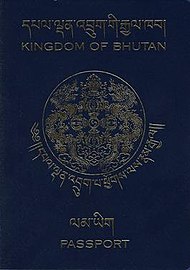Bhutanese passport
| Bhutanese passport | |
|---|---|
 The front cover of an ordinary (blue) Bhutanese passport | |
| Type | Passport |
| Issued by | |
| First issued | app. 2006[1](current version) |
| Purpose | Identification |
| Eligibility | Bhutanese citizenship |
| Expiration | Ten years |
ABhutanese passportis a document that authorizes and facilitates travel and other activities inBhutanor by Bhutanese citizens. Foreign travel passports are issued to citizens of Bhutan for international travel by theMinistry of Foreign Affairs.It is valid for all countries unless otherwise endorsed.[2]
History[edit]

In theKingdom of Bumthang,which constitutes a part of modern-day Bhutan, feudal passbooks ordzeng(Dzongkha:ཛེང) were issued to court messengers in order to travel from kingdom to kingdom.[2]Diplomacy and mediating were crucially important measures in pre-modern Bhutan chiefdoms.[3]
Foreign travel passports are issued to citizens of Bhutan for international travel. New Bhutanese passports are issued by the foreign affairs.
In 1988, Bhutanese passport holders abroad were ordered to surrender their passports upon their return to Bhutan.[4]
The current version of the Bhutanese passports were first issued around 2006.
Languages[edit]
The passport contains text in English andDzongkha.[5]
Types of passport[edit]
| Type of passport | Color | Image |
|---|---|---|
| Ordinary passport (Dzongkha:་དགེ་འདུན་,romanized:Shinthron) | Blue | 
|
| Official passport (Dzongkha:དབྱངས།་,romanized:Pawchang) | Green | |
| Diplomatic passport (Dzongkha:ཞག་དང་རྣ,romanized:Denzhen) | Red | 
|
In popular culture[edit]
In 2013, a spoken article on theEnglish Wikipediawas created for the Bhutanese passport by user KuchenZimjah,[6]which was interpreted as humorous, spawning aninternet meme.The audio file was deleted in 2015 following debate on the article's talk page.[7][8]In 2023, YouTube creatorHbomberguyused this recording as an example of audio versions of articles being anaccessibilityfeature and of recreating someone else's creative work in an ethical, productive way.[9]
See also[edit]
- List of passports
- Visa policy of Bhutan
- Visa requirements for Bhutanese citizens
- Bhutanese Citizenship Act 1985
References[edit]
- ^"Council of the European Union - PRADO - BTN-AO-01001".consilium.europa.eu.Retrieved6 August2019.
- ^abhttp:// nab.gov.bt/downloads/82NA%20resolution.doc[permanent dead link]
- ^༄༅།༅།ཆ༅ས༌ས༅ད་བར༅་གསར༌ར༅༅ང་ག༅༌ར༅མ༌གཞག༌ས༅༅ང༌ར༅༅འ༅་བ༅མ་པ།(PDF)(in Dzongkha).ISBN978-99936-15-07-1.Archived fromthe original(PDF)on 23 September 2015.Retrieved31 May2013.
- ^"Circular MFA/PD/14.19".Kuensel.15 January 1988.
- ^James Minahan (1 December 2009).The complete guide to national symbols and emblems.Greenwood Press.ISBN978-0-313-34498-5.
- ^Newman, Tim (20 March 2015)."Wikipedia's" Bhutaenese [sic] Passport "Audio Article Is The Funniest Thing You'll Hear All Week".Lazer Horse.Archivedfrom the original on 13 March 2024.Retrieved13 March2024.
- ^"When 'Bhutanese passport' was deleted from Wiki after being subjected to trolls".The News Minute.30 March 2015.Archivedfrom the original on 13 March 2024.Retrieved13 March2024.
- ^Lileks, James (27 March 2015)."The trouble with" Bhutanese Passport. "".Star Tribune.Archivedfrom the original on 13 March 2024.Retrieved13 March2024.
- ^Plagiarism and You(Tube)(video).Hbomberguy.2 December 2023. Event occurs at 3:33:14.Retrieved6 February2024– via YouTube.

